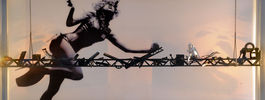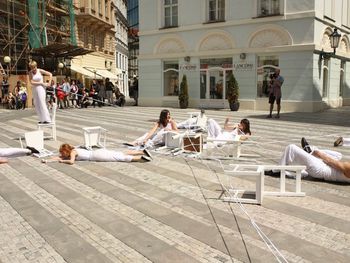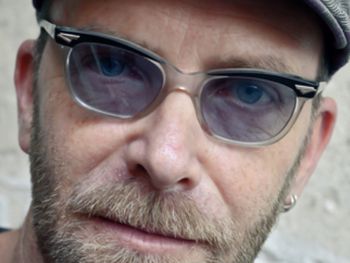PQ 2015
Hot News
THE INTERNATIONAL EXHIBITION: Countries and Regions
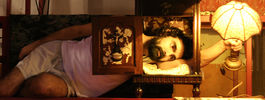
An exhibition of a thousand theatre artists from 60 countries and regions.
SHAREDSPACE 2013- 2016
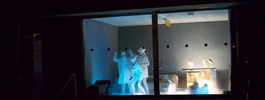
Art and research project presents symposiums, workshops or exhibitions in 11 countries.
OBJECTS
Objects and their stories – this is the main theme of “Objects”, an exhibition open to individual artists.


1979 » Italy » Stage and costume design
| Curator: | Giorgio Capezzani |
ITÁLIE
Stage design has been opened to the most varied experiments and has thus brings led to new ideas and innovations which make it possible to change the method by which the content of a play is conveyed to the audience in a theatrical language. In Italy a new, distinctive approach which provides sufficient space for the demands of the theatre to experiment with various forms, to alter the means of expression in the course of the performance and to provide the possibility of playing on tour in the far corners of the country, has been developed only partially. Moreover, in view of the decentralization of the theatre which has taken place, there is a demand for adapting stage designs to the immediate needs of various stages or auditoriums while only partially keeping in mind the place where the action is located. Thus scenic space with only basic and inconspicuous decorations is usually used, making it possible to constantly move surfaces , structures and even the position vis-à-vis the audience. A different stage designing approach requires a movable area with constant modifications in the width of the stage, accompanied by a revival of dramatic effects together with a seeking of non-traditional spatial solutions. One of the reasons for experimenting is the endeavor to utilize all empty spaces so that actors and various objects are constantly transforming the stage. A design which is closely linked with scenic space and material may often takes upon itself a basic function which becomes separate and symbolic. Due to this the actor's voice attains expressive nuances so that it is transformed into phonemic speech which helps to constantly renew and regenerate the rendering of the text. In theatrical troupes which function on the cooperative principle and use collective methods of work, which usually also have very limited resources, stage designs must be based on simple means and spontaneous invention. At this Quadrennial, professional stage designers are exhibiting their work for the traditional theatre, but they span various approaches : from the traditionalistic to the avant-garde. Some of these designers produce sets which use innovative approaches based on classical painting, while others stress experimentation. Stage design is a part of the culture it is closely affiliated with stage direction and together with it determines the critical outcome of a performance.
Exhibiting artists / ateliers
[show all | hide all]- Roberto FRANCIA
- Emanuele LUZZATI
- Antonello AGLIOTI
- Paolo BREGNI
- Ian Evans: (Rozkoš z počestnosti), 0
- Alberto Burri
- : (Tristan and Isolda), Teatro Regio Torino, director: F. Siciliani 1976
- Santuzza CALI'
- Memé PERLINI
- Mario RICCI
- Vittorio ROSSI
- Enrico SIRELLO
Additional information: Born in Rome. Since 1963 he has been cooperating with L. Damiani at the Teatro Stabile in Bologna, as well as designing stage sets for other Italian theatres. He participated in the PQ 1975, where he received a Silver Medal for the stage design for Shakespeare's Hamlet and m the PQ in 1979.
Obrázky z kataloguAdditional information: Born in 1921 m Genova. He studied at the School of Fine Arts in Lausanne. He has worked as a painter, illustrator and above all as a set and costume designer. He collaborates with Giulio Gianini and together with him has made several feature and car - toon films, the best known of which include Paladini, The Thiev - ing Magpie, Pulcinella / the latter two were nominated for an Oscar/ and most recently The Magic Flute /1978/. Among his most important stage designs are those for productions of Ionesco' s The Rhinoceros, Ruzzante' s Dialogues, The Girl of Ancona and The Flirt, as well as for T. Stopparď s Rosencrantz and Guildenstern are Dead, Fersen' s Lea Leibowitz and Golem, Shakespeare' s Titus Andronicus, Macbeth, The Taming of the Shrew and A Mid - summer Nighťs Dream, Brechť s Mr Puntila and His Man Matti, Man is Man and The Good Soldier Schweyk in the Second World War, Dreyer' s Jesus, directed by Trionfo' s end Gassman' s Either Caesar or Nobody, directed by the author. He also collaborated on productions of Jonson´ s Volpone the Fox, directed by Squarzina, Bruckner' s Leonce and Lena, directed by Fersen, Jarry´s Ubu Bound directed by Conte, Erdman' s The Suicide, directed by Marcucci, Conte' s The Golden Cock, directed by the author,Tieck' s Puss in Boots, directed by Corsini and Strindberg' s Svanevit directed by Conte. He has also designed sets and costumes for the foremost opera theatres, both in Italy and elsewhere, for instace for the English Opera Group, for the Glyndebourne Festival, for the Chicago Opera House, the State Opera in Vienna, for the Münchner Festspiele, the London Ballet Festival and for a number of other theatres. He has written and illustrated nume - rous books for children and received a prize for illustrations at the Bratislava Biennial of Book Illustration in 1967. He participated in the Prague Quadrennial in 1975. Luzzati lives and works in Genova and in Rome.
Additional information: A stage designer and painter; he has collaborated with Memé Perlini in designing the stage sets for all his productions. The designs on exhibit are working sketches which were made in the course of rehearsals, since Aglioti is a stage designer who never prepares beforehand the designs of sets, but creates them together with the stage director and the actors, according to the demands posed by the specific available space and the course of the production. The artist is such cases limits himself to providing the colour of the costumes and the sets on the stage on which he is working. There is no place for make-belive decorations, there is nothing artificial or false, but only theatrical judgement and abstraction of its own structure.
Obrázky z kataloguAdditional information: Born in 1937 in Milan. As a stage designer he has been cooperating with theatres in Italy and abroad. His collaboration with stage director G. Strehler at the Piccolo Teatro in Milan is most significant. He participated in the PQ in 1979.
Obrázky z kataloguExhibiting works
Additional information: Text from the Catalogue PQ1975: ○○○○○ Born in 1915 in Citta di Castello.By profession a physician /doctor of me- dicine/, he began to paint while in a prisoner of war camp in Texas, USA, where he was from 1943. Since the end of World War II he has devoted himself to painting; he settled in Rome but often visits Citta di Castello and the US. In 1955 he married the American dancer and choreographer Minsa Craig. His rationalistic abstract paintings proclaiming freedom of artistic creatvity were first successful in 1949. Burri's cycle Burning, under the influence of tachism dates from 1956. After 1958 he made Metals, Wood and Plastics, whose essence is in no case determined by the value of the material - he uses scrap material, which has its own history and past /Argan/. At the Teatro continuo Burri uses cement and steel.The Adventures of a Poor Christian by Silone holds a special place in his work for the theatre and stage desings, as well as the stage sets for Pistoni's ballet in the Teatro alla Scala in Milan and the stage sets for the Minsa Craig Ballet at the Teatro dell'Opera in Rome.○○○○○ Text from the Catalogue PQ79:○○○○○ Born in 1915 in Citta di Castello. His original profession is a physician; he began to paint in a POW camp in Texas, USA , where he was from 1943. After the end of the war he devoted himself entirely to painting and settled in Rome, but often visited Citta di Castello, as well as the US. In 1955 he married the American dancer and choreographer Minsa Craig. He was first successful in 1949 with rationalist abstract paintings proclaim ing the freedom of artistic creation. In 1956 he produced a collection of ceramics influenced by Tachisme. After 1956 he began to work in metals, wood and plastics - the value of these pieces is not in the price of the materials used, since Burri mostly uses scrap material. From among his designs of theatres we must mention the Teatro Continuo where he used steel and concrete at the Sempione Park in Milan in 1973 at the XVth Triennial, in the section devoted to art and the city; the theatre was placed on a green lawn framed on the one side by the Sforza palace and a Triumphant Arch on the other. Also his design of an open theatre in the town of Arcevia near Ancona, built within the framework of the construction on the Comunita Esisten - ziale should be mentioned. Among his stage designs his sets for Pistoni's Ballet Spirituals, produced in 1963 at the La Scala in Milan was of great interest, as well as those for Silone's The Adventures of a Poor Christian played at San Miniato al Tadesco in 1969, for November Step, a ballet by Minsa Craig produced in 1972 at the Teatro dell'Opera in Rome and for Wagner' s Tristan and Isolda at the Teatro Regio in Turin in 1976. He participated in the Prague Quadrennial in 1975, in the section for theatre architecture.
Obrázky z kataloguExhibiting works
Additional information: Born in Friuli. She studied at the Academy of Fine Arts in Pa - lermo and in the years 1957-1961 at the Summer Academy of Fine Arts in Salzburg with Oscar Kokoschka where she received three prizes for painting; later she became a teaching assistant at this Academy. She is also active as an illustrator and graphic artist and works in metal and wood and as a puppet maker. She has also worked for television, as a set and costume designer and since 1969 she has been collaborating with a number of the- atres . In recent years she has designed costumes for Shakes - peare' s A Midsummer Nighťs Dream, directed by Marcucci, the sets and costumes for Conte' s Pulcinella in Town, directed by the author of the play, the costumes for Brechť s The Good Woman of Setzuan, directed by B. Besson, for Brechť s Schweyk in the Second World War, directed by Marcucci, for Ramón del Valle Inclan' s Magic Words, directed by Enriquez, for Witkiewicz' s In a Small Country Manor, directed by Salines, the sets and costumes for the History of Juan the Seducer by Kierkegaarde, di - rected by Lerici and Bufalini, the costumes for Oidipus at Colonus, directed by Trionfo, for The Erogs by Aristophanes, di - rected by Guicciardini, for Don Perlimplino by Fersen, directed by the author, the sets and costumes for Ferdausi' s Rostam and Esfandiar, directed by Kheradmand, the costumes and sets for The Women at the Festival by Aristophanes, directed by Salvatti and the costumes for Strindberg' s Svanevit, directed by Conte. She participated in the Prague Quadrennial in 1975.
Obrázky z kataloguAdditional information: Maria Signorelli founded the Opera dei Burattini puppet theatre in 1947 in Rome and was its superintendent until 1973, when she retired. In that year and under a new name / Opera dei Burattini la Scatola/ the theatre became an experimental group led by Josephine Volpicelli. The group now functions as a permanent theatre in Rome at the Cantastorie-Trastevere Club and has on its repertoire programs for adults, as well as for children. It also plays for various schools and collaborates with various public and private institutions. Almost all the puppets were made by Maria Signorelli and the stage sets, when they are used, have been designed by various painters. The stage direction and choreography of various per - formances are entrusted to various artists, according to the nature of the play. Besides various glove-puppet performances, the theatre also has programs in which the audience participates in the action and is thus able to express its own participation in the performance. During the period of its existance, the the - atre has participated in various important international festivals and has represented Italy in almost all the countries of Europe, Asia, Africa and Australia.
Obrázky z kataloguAdditional information: Born in 1947 in Romagna. He studied at the Academy of Fine Arts in Urbino. For one year after graduation he taught the history of art and drawing. When in 1968 he moved to Rome he made first contacts with the Roman experimental theatre. He made his debut as a stage director in 1971 with Pirandello' s Who?, after which followed Tarzan /in Rome/, Candore Giallo con suone di mare /in Pescara/, Othello /at the Biennial in Venice/, Landscape No. 5 / at the Festival in Chieri/, Locus Solus /in Rome/, The Departure of the Argonaute/ /at the Maggio Musicale Fiorentino/, Betrayals No. 1 /at the Cantiere Internazionale ďArte in Montepulciano/, Betrayals No. 2 /at the Biennial in Venice/ and The Awakening of Spring /in Rome/. His productions participated in the International Theatre Festival in Nancy, at the Espace Pierre Cardin in Paris, The Autumn Festival at Bordeaux, the Mikery in Amsterdam, BITEF in Belgrade and a number of festivals in Italy.
Obrázky z kataloguAdditional information: Born in 1933; in 1959 he settled in Paris, since 1961 he worke for the Marionetteatern in Stockholm. A year latler he returned to Rome, where he founded the Movimento numero uno per mario - netta sola. In 1964 he organized a small theatre and club, the Grupp di Sperimentazione Teatrale Orsoline 15, with a theatrical workshop in which various kinds of artist /including painters and poets/ worked with the objective of completing the given action outline. After a period in which his main stress was upon professionalism, he started to experiment in the area of the ''actor - object" relationship, in connection with the concept of the theatre as ''games and rituels " . In 1969 he opened the Abaco Theatre. The names of his productions served only a pretext for the "performance proper ' ' by Ricci which he prepares without any work scheme or notes on direction, but rather develops the performance on the basis of an analysis of the suggestions made by each of his collaborators; in this way he errives at a specification of his objective and can then plan its course. During rehearsals the problem is further crystalized into the model of a story. In the final stage of work in this theatrical laboratory, ideological, as well as manual and physical aspects are mutually intertwined, since every member of the group is at the same time a cabinet-maker, srnith, e l e c t r i - cian, painter, actor, etc. The films and slides which are used in the performance are en integral part of the production; often they are projected to mobile screens /both actors and objects/. Among Ricci's productions the most interesting are Varieté, Gulliver's Travels, Edgar Allan Poe, James Joyce, Baron Münchhausen, King Lear according to the Great Playwright W.Shakespeare, Moby Dick, Odysseus and Three Oranges. Carlo Montesi,Claudio Previtera and Mario Romano have worked as his stage de - signers. Angela Diana designs the costumes. Ricci's theatre has participated in the most significant festivals held in I t a l y and elsewhere.
Obrázky z kataloguAdditional information: Graduated as an architect from the University in Rome. He designs stage sets and costumes for films, drama theatres, the opera and ballet, both in Italy and abroad. A number of his films have been shown at Italian or foreign film festivals. He works as a stage and costume designer at the Gli Associati Theatrical Company, one of the foremost in Italy. For this company he has designed the sets and costumes for the plays of Shakespeare, Pirandello, O´Neill, Sartre, Chekhov, Sophocles, Alfieri, Hofmannsthal and others. He has also worked for Det Kongelige Teater in Copenhagen, for the La Scala in Milan, the Teatro Reggio in Turin, for the Stads-Schouwburg in Amsterdam and for the Festival D´ Orange. He has gained international recognition for his designs for the Arena in Verona and for the sets for the operas Boheme, Tosca, Turandot, Aida, Cavaleria Rusticena, I Pagliacci and the Sleeping Beauty. For five years he served as stage design advisor to the Arena in Verona. In all his work it is possible to follow endeavours to express austerity and to capture the essence and objectives of a modern, critical approach to drama and musical elements, which would provide audiences with fundamental ideological and visual experiences and would not be mere decorations. Thee most significant and most original constitu - tion of Rossi´ s work is in his very modern approach to the uninterrupted creation of action and the development of characters through the technical and symbolic figurative language of our age.
Obrázky z kataloguAdditional information: Born in 1930 in Leghorn. He graduated from art school in Florence and now lives and works in Rome. He is active not only as a stage designer, but also as a painter. Within the framework of Italian structuralism he has held several one-man exhibitions. Among them the following should be mentioned: In Rome in 1963, 1972, 1973 and 1978, in Florence in 1963 and 1975, in Genova in 1971, in Naples in 1976, in Milan in 1977 and in Leghorn in 1954, 1965, 1971 and 1978. In the years 1960-1965 he managed an experimental theatrical company in Leghorn, where as director he staged eight- een performances, among them Camus, Misunderstanding in 1960, Beckeť s Waiting for Godot in 1961, Borcherť s Outside the Door in 1962, Ionesco' s Amédéa or How to Get Rid of Him in 1962 and Pingeť s Dead Leaves in 1962. In 1969 he managed the adaptation of the Pirandello, now the Tordinona Theatre, where he built a modular stage at three various planes; in 1969 at the Sky - scraper Theatre in Leghorn he built a rotating stage which makes it possible by the sirnple operations of moving, rotating and overlapping sections to immediately change the layout of the stage and the design of the sets. Among his stage designs the following should be mentioned: T. S. Elioťs Murder in the Cathedral in 1957, A. Miller' s Death of a Salesman in 1960, Prietsley' s The Inspector at Birlings in 1960, Boggio-Cuomi's Santa Maria dei Battuti in 1964, Moretti' s The Trail of Giordano Bruno in 1970, Böll' s Leprosy in 1973, Moretti´s and Alighiero's A Ballad for Tommaso Campanella in 1978 end D' Annunzio' s The Torch Under the Bushel in 1978.
Obrázky z kataloguAdditional information: For the past thirty years the Accetella Puppet Theatre /Teatro delle Marionnette degli Accettella/, directed by Icaro, Anna and Bruno Accettella, has been playing from October to June at the Pantheon Theatre in Rome. Several years ago a theatrical workshop was founded, where the Accettellas study various new puppet methods and in collaboration with a number of municipal cultural institutions/such as the Teatro Scuola del Teatro di Roma, the Instituto di Psicologia del Magistro, Distretto Sco - lastico Educativo della RAI/TV / organise courses and seminars. The Accettellas play various authors and playswith their puppets but their most fortunate discovery have been folk fairy tales. The theatres owns almost three hundred wooden puppets; the oldest among them are simply carved with a knife, while the most recent have grotesquely conceived shapes - they are the result of close collaboration with the sculptor Ferdinando Codognoto from Rome. The Accettella' s puppet theatre has played not only in the foremost Italian theatres /Cajo Melisso in Spoleto, in Regio de Parma, Tempio Malatestiano in Rimini, Marrucino in Chieti/, but it has also participated in the 5th International Festival in Parma and at the lst National and International Puppet Exhibition in Bogota, Colombia.The theatre has also produced a number of films and documentaries and it can often be seen on Italian TV. The Nuove Edizioni Romane Publishing House has published a book by the Accettella family, "Diciamolo con le marionnette ", where their extensive experiences with puppet playing are described. The book was very successful at the International Book Trade Fair in Bologna in 1978; it also represented Italian books at the Book Trade Fair in Frankfurt.
Obrázky z kataloguAdditional information: The Pasqualino Brothers Theatre of Sicilian Puppets was founded by the brothers Fortunato and Pino Pasqualino in 1969 and uses puppets which are typical for their native southern Sicily. The Pasqualino brothers have played an important role in the revival of the rich folk traditions of the Sicilian puppet theatre, especially with plays they have written themselves. Fortunato Pasqualino, who as a writter was already well known by his literary activities in other areas, has written, among others, the following plays for the puppet theatre: Don Quijote, Moses and the Pharaoh, The Sword of Rolland, Garibaldi, The Temptation of Jesus, Pinocchio at the Court of Charlemagne, Amphytryon from Sicily and Francis of Assisi. The Pasqualino Brothers Theatre plays all over Italy, as well as in various international puppet festivals and competitions, for instance at Terni, Parma, Mantova, etc, and also in Switzerland and in the USA. Their puppets have also made their appearance in Italian, Austrian, Danish and US Television. The Pasqualino brothers have a mobile stage, which can be assembled during several hours. The stage designer of their theatre is Marisa Fogliarini Farina, costumes are designed by Angelo D´Angelo.
Obrázky z katalogupq@pq.cz | tel.: +420 224 809 102 | We use content management system Vizus CMS
